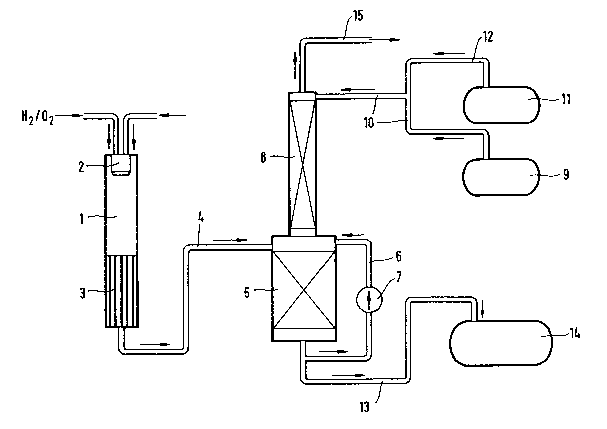Une partie des informations de ce site Web a été fournie par des sources externes. Le gouvernement du Canada n'assume aucune responsabilité concernant la précision, l'actualité ou la fiabilité des informations fournies par les sources externes. Les utilisateurs qui désirent employer cette information devraient consulter directement la source des informations. Le contenu fourni par les sources externes n'est pas assujetti aux exigences sur les langues officielles, la protection des renseignements personnels et l'accessibilité.
L'apparition de différences dans le texte et l'image des Revendications et de l'Abrégé dépend du moment auquel le document est publié. Les textes des Revendications et de l'Abrégé sont affichés :
| (12) Demande de brevet: | (11) CA 2128659 |
|---|---|
| (54) Titre français: | PROCEDE POUR L'ELIMINATION DE HALONS OU DE FLUOROCARBURES OU CHLOROFLUOROCARBURES EN CONTENANT |
| (54) Titre anglais: | PROCESS FOR THE DISPOSAL OF HALONS OR HALON-CONTAINING FLUOROCARBONS OR CHLOROFLUOROCARBONS |
| Statut: | Réputée abandonnée et au-delà du délai pour le rétablissement - en attente de la réponse à l’avis de communication rejetée |
| (51) Classification internationale des brevets (CIB): |
|
|---|---|
| (72) Inventeurs : |
|
| (73) Titulaires : |
|
| (71) Demandeurs : |
|
| (74) Agent: | SMART & BIGGAR LP |
| (74) Co-agent: | |
| (45) Délivré: | |
| (22) Date de dépôt: | 1994-07-22 |
| (41) Mise à la disponibilité du public: | 1995-01-25 |
| Requête d'examen: | 2001-07-05 |
| Licence disponible: | S.O. |
| Cédé au domaine public: | S.O. |
| (25) Langue des documents déposés: | Anglais |
| Traité de coopération en matière de brevets (PCT): | Non |
|---|
| (30) Données de priorité de la demande: | ||||||
|---|---|---|---|---|---|---|
|
-1-
Abstract of the Disclosure
Process for the disposal of halons or halon-containing
fluorocarbons or chlorofluorocarbons
The invention relates to a process for the disposal of
halons or halon-containing FCs or CFCs, wherein the
latter are thermally or photochemically decomposed in the
presence of a hydrogen source, the gas produced,
containing HF, HBr, CO2, water and, if appropriate, HCl,
is cooled, the hydrogen halides are absorbed in a
scrubbing liquid in a gas scrubber column and neutralized
with a base, and any elemental bromine or chlorine
contained in the gas is reduced to the corresponding
salts with a reducing agent.
Note : Les revendications sont présentées dans la langue officielle dans laquelle elles ont été soumises.
Note : Les descriptions sont présentées dans la langue officielle dans laquelle elles ont été soumises.

2024-08-01 : Dans le cadre de la transition vers les Brevets de nouvelle génération (BNG), la base de données sur les brevets canadiens (BDBC) contient désormais un Historique d'événement plus détaillé, qui reproduit le Journal des événements de notre nouvelle solution interne.
Veuillez noter que les événements débutant par « Inactive : » se réfèrent à des événements qui ne sont plus utilisés dans notre nouvelle solution interne.
Pour une meilleure compréhension de l'état de la demande ou brevet qui figure sur cette page, la rubrique Mise en garde , et les descriptions de Brevet , Historique d'événement , Taxes périodiques et Historique des paiements devraient être consultées.
| Description | Date |
|---|---|
| Inactive : CIB désactivée | 2011-07-27 |
| Inactive : CIB en 1re position | 2007-01-02 |
| Inactive : CIB attribuée | 2007-01-02 |
| Inactive : CIB expirée | 2007-01-01 |
| Inactive : CIB de MCD | 2006-03-11 |
| Inactive : CIB de MCD | 2006-03-11 |
| Le délai pour l'annulation est expiré | 2005-07-22 |
| Demande non rétablie avant l'échéance | 2005-07-22 |
| Réputée abandonnée - omission de répondre à un avis sur les taxes pour le maintien en état | 2004-07-22 |
| Lettre envoyée | 2001-07-20 |
| Inactive : Renseign. sur l'état - Complets dès date d'ent. journ. | 2001-07-20 |
| Inactive : Dem. traitée sur TS dès date d'ent. journal | 2001-07-20 |
| Exigences pour une requête d'examen - jugée conforme | 2001-07-05 |
| Toutes les exigences pour l'examen - jugée conforme | 2001-07-05 |
| Demande publiée (accessible au public) | 1995-01-25 |
| Date d'abandonnement | Raison | Date de rétablissement |
|---|---|---|
| 2004-07-22 |
Le dernier paiement a été reçu le 2003-06-03
Avis : Si le paiement en totalité n'a pas été reçu au plus tard à la date indiquée, une taxe supplémentaire peut être imposée, soit une des taxes suivantes :
Veuillez vous référer à la page web des taxes sur les brevets de l'OPIC pour voir tous les montants actuels des taxes.
| Type de taxes | Anniversaire | Échéance | Date payée |
|---|---|---|---|
| TM (demande, 3e anniv.) - générale | 03 | 1997-07-22 | 1997-06-27 |
| TM (demande, 4e anniv.) - générale | 04 | 1998-07-22 | 1998-05-29 |
| TM (demande, 5e anniv.) - générale | 05 | 1999-07-22 | 1999-05-28 |
| TM (demande, 6e anniv.) - générale | 06 | 2000-07-24 | 2000-06-01 |
| TM (demande, 7e anniv.) - générale | 07 | 2001-07-23 | 2001-07-04 |
| Requête d'examen - générale | 2001-07-05 | ||
| TM (demande, 8e anniv.) - générale | 08 | 2002-07-22 | 2002-06-14 |
| TM (demande, 9e anniv.) - générale | 09 | 2003-07-22 | 2003-06-03 |
Les titulaires actuels et antérieures au dossier sont affichés en ordre alphabétique.
| Titulaires actuels au dossier |
|---|
| SOLVAY (SOCIETE ANONYME) |
| Titulaires antérieures au dossier |
|---|
| ROLF-MICHAEL JANSEN |
| RUDIGER WALZ |
| THEODOR AUEL |
| WOLF-DIETMAR KAUFMANN |